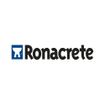
Ronacrete RonaBond Flowable Micro Concrete
RONABOND FLOWABLE MICRO CONCRETE
RONABOND FLOWABLE MICRO CONCRETE
Prepacked mortars for hand applied flowable concrete
RonaBond Flowable Micro Concrete is a repair concrete used in place of hand applied mortars to repair and replace sections of concrete.
INFORMATION
PACKAGING
RonaBond Flowable Micro Concrete is supplied in 25kg bags.
YIELD
-0.0118m³ (pourable consistency) per 25kg unit -0.0125m³ (fluid consistency) per 25kg unit
BRAND
Ronacrete
HEALTH AND SAFETY
Refer to Safety Data Sheet.
STORAGE
RonaBond materials should be stored unopened between 5°C and 25°C in dry warehouse conditions and out of direct sunlight. In these conditions shelf life is approximately 6 months.
FEATURES AND BENEFITS
-Conforms to BS EN 1504-3 -Shrinkage compensated -Protects steel reinforcement -High strength flowable micro concrete -Free flows in to shuttering and formwork -Can be trowelled, poured or pumped
DETAIL
Designed for pour and pump application the material is poured in to shuttering to reform concrete profiles. It is shrinkage compensated and provides high early and ultimate strengths. Flow is affected by temperature.
WORKING TEMPERATURES
RonaBond Flowable Micro Concrete can be used in most weather conditions and in a wide temperature range, typically from +3°C on a rising thermometer to 30°C; at low temperature the flow of the material will be affected and at 25°C + the working time of the mix will be reduced. Warm weather working techniques are required above 25°C. Ideally store materials between 10oC and 20oC before use.
DOWNLOADS
↓ Data Sheet
↓ Safety Datasheet
PHYSICAL PROPERTIES (CONTINUED)
Bond Strength
3 days 2.0N/mm²
7 days 2.5N/mm²
28 days 3.0N/mm²
Note that all quoted data is based on laboratory tests conducted at 20oC. Cubes are cured under polythene for 24 hours and then and air cured. Results shown are typical laboratory strengths achieved by casting and curing cubes in ideal working conditions; site strengths may be lower.
PHYSICAL PROPERTIES
COMPRESSIVE STRENGTH @ 20°C (FLOWABLE
- 1 day : 10N/mm²
- 3 days : 30N/mm²
- 7 days : 50N/mm²
- 28 days : 70N/mm²
TENSILE STRENGTH
- 3 days 2.5N/mm²
- 7 days 3.5N/mm²
- 28 days 4.0N/mm²
COMPRESSIVE STRENGTH @ 20°C (FLUID)
- 1 day 5N/mm²
- 3 days 25N/mm²
- 7 days 40N/mm²
- 28 days 60N/mm²
COMPRESSIVE STRENGTH @ 5°C (FLOWABLE)
- 1 day N/A
- 3 days 5N/mm²
- 7 days 20N/mm²
- 28 days 40N/mm
INSTRUCTIONS FOR USE
PUMPED APPLICATION TO SEALED SHUTTER
-When repairing soffits, flat horizontal concrete surfaces should be avoided to avoid entrapment of entrained air.
-Construct a watertight shutter with a single port for pumping, positioned at the lowest point of the shutter. Position bleed pipes at the top and bottom corners of the shutter to allow residual water, trapped and entrained air to be released. The shutter must be sufficiently strong to prevent displacement or deflection during the pour -Fill the shutter with clean water at least two hours before the pour commences, longer if the concrete is very porous and drain when ready to start the repair process.
-The shutter may be removed after 48 hours @ 20oC, longer at lower temperatures, but the exposed material must then be protected from drying winds and frost by application of Ronacrete Curing Membrane spray applied curing agent. -Mix RonaBond Flowable Micro Concrete using a suitable forced action mixer/pump, such as Putzmeister SP 11 LMR and pump into the shutter from one position only, to avoid air entrapment. Pumping should be continuous and material waiting to be placed should continue to be agitated. When undiluted grout seeps from the bleed pipes the pipes must be capped. The material must not be vibrated but the shutter may be tapped to displace air bubbles.
PREPARATION AND PRIMING
-All concrete identified for removal must be cut out by approved means toexpose a suitable substrate which is sound, stable and strong enough to accept RonaBond Flowable Micro Concrete. -Concrete around steel reinforcement must be fully removed, to provide a gap of 15mm between concrete and steel, until clean uncorroded steel is exposed. Loose rust and scale must be removed. Heavily corroded steel should be assessed by the engineer and replaced as necessary. When repairing chloride contaminated concrete, exposed steel must be grit blasted to expose bright, uncorroded steel before washing to removeresidues.
-Saw cut around repair perimeters to a minimum depth of 10mm at 90°, to avoid feathered edges and remove all concrete within saw cuts which is ≤15mm from the repair surface -Exposed concrete surfaces must be suitably textured, scabbling or needle gunning may be required, depending on the method of concrete removal -All surfaces must be thoroughly cleaned to remove all loose materials and surface contamination which may prevent inhibit adhesion. -Brush apply two coats of Ronacrete Standard Primer to the steel and cast 0.8-1.7kg (or similar) kiln-dried sand into the second coat.


